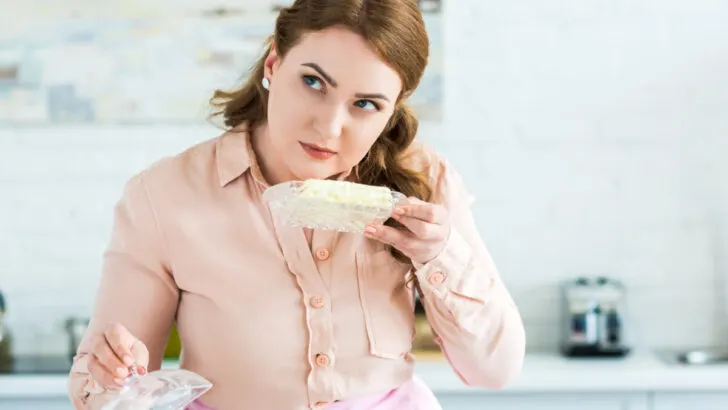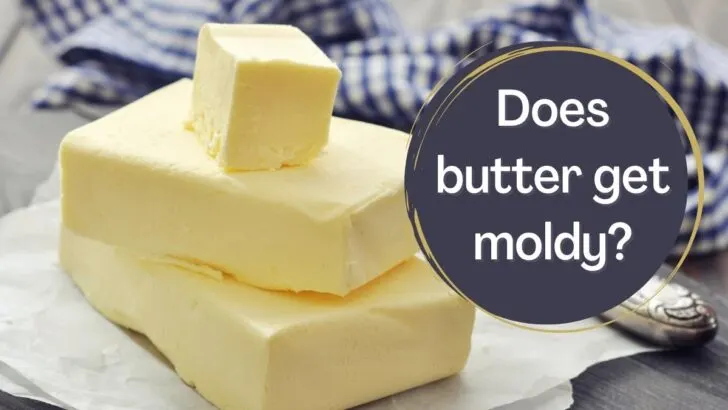Butter is a delicious ingredient, integral to many foods. The last thing any chef wants to see is butter growing mold. But you rarely see butter growing mold. Can butter grow mold?
Butter can grow mold. It is rare to see it, but it can happen with enough time and heat. Butter lasts longer if it’s left in the fridge rather than out in the open.
If the butter is on the table, it will grow mold faster than if it is in the fridge. Most people eat butter long before it can grow mold.
Does Butter Get Moldy?
So many of our groceries grow mold and become inedible before we have a chance to finally cook them.
I can’t even count the number of times I have reached in my vegetable drawer for a bell pepper only to find a sad, dark green, withered vegetable cemented on the bottom of the drawer.
Many of the foods that we eat eventually grow mold. Once food grows mold, they become inedible.
My fruits and vegetables are not the only foods that grow mold. Dairy often grows mold. If a stick of butter sits in the fridge for long enough, it will also become moldy.
So how long does it take for butter to finally grow mold? It depends on the salt content of the butter. Salt is a mold inhibitor. So unsalted butter will grow mold faster than salted butter.
However, butter will change its attributes before finally growing mold. If you try to cut into a piece of butter and find that it is harder to cut than usual, then the moisture in the butter will evaporate.
Do not eat hard butter as it is rotting. It may not smell like it is rotting, but hard butter can cause mild food poisoning.
Can I Cut Off the Mold and Eat the Good Parts?
Cutting off the mold off a piece of bread, plastic cake, a vegetable, or a fruit makes it edible again, right?
Actually, no one should eat a piece of food that has a small bit of mold on it. No matter how small that mold chunk is, once it appears, that piece of food should not be eaten.
In order for mold to grow on a piece of food, the mold all around a piece of food has to be strong enough to bloom. This requires millions of tiny mold spores.
Even if there is a small growth of mold on one small section of the fruit or vegetable, it means that there is enough mold on the entire food to bloom.
You could eat millions of tiny mold microbes without knowing it. So when you spot a piece of mold on fruits, vegetables, bread, or meat, that means it’s time to throw it away.
If the butter in your fridge grows mold, you cannot save the butter by removing the moldy part. I’m afraid you’re going to have to throw out the entire stick of butter.
It is not safe for human beings to consume mold.
It is rare that you see mold sprouting from a stick of butter, but it happens from time to time.

How to Prevent Food From Growing Mold
There are few ways to prevent butter from growing mold. Luckily, it takes a very long time for butter to grow mold. As long as you eat the butter within 2 months, you won’t ever see a speck of green on it.
But other foods in our fridges can grow mold quickly. As we explained before, we’ve all reached for our favorite vegetable to add to our stir fry and found that we had to chuck it into the trash because there were little green patches of fur growing all over it.
So how can you prevent food from growing mold?
Soak the Food in a Vinegar Wash
When you bring home your vegetables and fruits from the grocery store, don’t just put them away in the refrigerator and shelves.
Soaking the fruits and vegetables in a vinegar wash for 20 to 30 minutes can help kill any mold spores that have made their homes on the surfaces of these foods.
Remove the Groceries from Plastic Bags
The plastic bagging that allows us to carry and organize food while shopping at the grocery store can promote mold growth. As the vegetables sit in the plastic bag, they can expel moisture.
It is fine if the moisture stays in the vegetable or fruit. But when the moisture seeps out and into the bag, that is when it interacts with the mold spores sitting on the fruits and vegetables.
The moisture and humidity in the bag will stimulate mold growth.
So when you have vegetables and fruits in plastic bagging, remove them before placing them in the fridge. Also, place several paper towels down wherever you plan to place your fruit or vegetables.
The paper towel will help absorb any moisture. Then you can remove the paper towel and place a new one the next day.
Conclusion to Butter Growing Mold
Yes, butter grows mold, but unsalted butter will grow faster than salted butter. If you see mold growing on a stick of butter, throw it away.
In fact, you should not eat any food that has mold on it. It doesn’t matter if you cut off the mold, there are still millions of mold microbes lurking inside the food.
To preserve fruits and vegetables, kill the mold sitting on their surfaces by washing them in a vinegar bath for half an hour.


